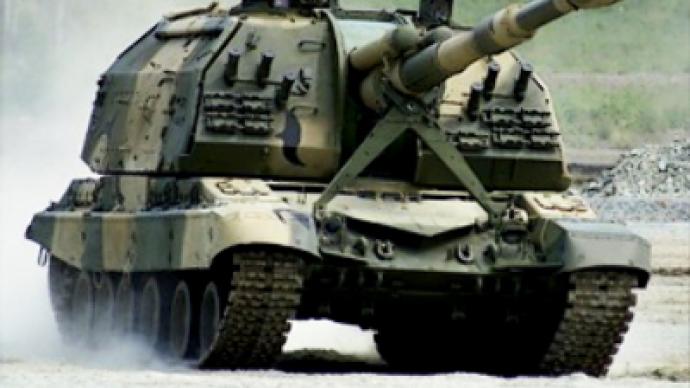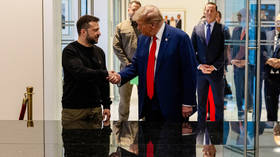Copycat weapons a threat to Russia's economic security

Pirate production is among the key problems of the global weapons market. Superpowers that used to help their allies establish their own defense industries during the Cold War now face the consequences of that help.
Many countries have created successful copies of foreign weapons and do not need to import arms any more. Furthermore, weapon clones are offered for export, which poses an immediate economic threat for major players in the arms market.
Copying weapons is a worldwide policy favored by countries whose scientific potential and defense industry are not up to the task of producing this or that type of weapons or lack a certain technology. As early as during World War II, combating countries did their best to get hold of the most successful weapon models. For example, Germany was trying to produce something similar to the USSR’s Katyusha MLRS, but their multiple-launch systems were still inferior to the Soviet original. Also, the Wehrmacht recognized the advantages of the T-34 tank, whose efficient sloped-armor design was used in Germany’s Panther tank.
The USSR, too, copied Allied equipment. By the end of the war, the USSR began working on a strategic bomber project, and the Americans involuntarily assisted Soviet designers in that. In 1944, B-29 Superfortresses made numerous emergency landings on Soviet Far East airfields after bombing missions in Japan and Manchuria. According to the Soviet-Japanese Neutrality Pact, the aircraft and their crews were subject to internment. Aircraft designers carefully studied the bomber and created its copy: the Tu-4, which was hard to tell from its American original.
Today, the main victim of weapons piracy is perhaps the famous Kalashnikov assault rifle. During Soviet times, licenses to produce the AK were granted to most Warsaw Pact countries, Cuba, China, Libya, Egypt, and Finland. In most cases, the deals were politics-driven, their goal being to ensure that all friendly armies field uniform weapons. Despite the expiration of the licenses, the Kalashnikov rifle is still manufactured in Hungary, Poland, Croatia, Slovakia, and even the US. Rosoboronexport is trying to change the situation by claiming royalties or seeking new license agreements. However, according to the company, only China has so far obtained a new license to manufacture the world’s most popular assault rifle.
The pirate parade
China is the world-recognized leader in arms copying. This is largely due to the fact that the entire Chinese economy is based on borrowing foreign technology. Besides this, the country has a well-developed defense industry, so its copycats are quite good. The scale of “reproductions” was obvious at the military parade commemorating the 60th anniversary of the People's Republic of China. The Chinese leadership made a point of the fact that only Chinese-made vehicles and equipment took part in the parade.
In reality, many models presented that day clearly had foreign origins. The FT-2000 surface-to-air missile system is a carbon copy of Russia’s S-300. China never obtained a Smerch multiple rocket launcher from Russia, but fields its own look-alike PHL-03 system. The People’s Liberation Army has a “carbon copy” of the Russian-made Msta self-propelled howitzer under the designation of Type 88. A clone of Russia’s BMP-3 is an infantry fighting vehicle with a Russian turret mounted on Chinese ZBD-05 chassis.
Sometimes, Chinese designers create hardware blending two foreign origins at once. For example, the PGZ-04 self-propelled air defense system features 25-mm cannons taken from Italian SIDAM-25 AD system and four QW-2 missiles that copy Russia’s Igla-1. Quite often, Chinese copies, upon permission by China, are further reproduced in other countries. France’s Crotale short-range air defense system has become HQ-7 in China, but that same system, under the designation of Shahab Thaqeb, is now produced in Iran.
According to experts, China has made great progress in copying missile technology. Having purchased the X-55 missile from Ukraine, the Chinese created their own DH-10 cruise missile.
License with no guarantee
Quite often, a license to manufacture military equipment is not protection from copying but quite the opposite: a rather legal way to obtain samples for the development of similar weapons.
Ruslan Pukhov, head of the Strategy and Technology Analysis Center, says software codes are not transferred under military equipment supply agreements. Also, there are restrictions on essential and most complex components and systems of the armaments in question; such items are usually supplied assembled by the supplying country. However, sales of equipment without sales of technology are impossible, Mr. Pukhov says; some countries (e.g. India) flatly refuse to consider offers that do not provide for production technology handover.
China uses production licenses to create helicopters and airplanes. France’s helicopter SA-365 Dauphin 2 has been upgraded to the WZ-09 combat chopper. However, the clearest example of “licensed copying” is the Chinese J-11 fighter jet, based on Russia’s Su-27. In 2006, Moscow and Beijing struck a deal on licensed production of the Su-27SK (Chinese designation J-11A). The agreement only provided for licensed assembly of components provided by Russia. The Chinese, though, studied the aircraft while assembling it and ended up producing a similar fighter, the J-11B, only with a Chinese-made engine and avionics.
Tehran is keeping up
Iran, spurred by its aspiration to become the leader of the Islamic world yet strangled by numerous sanctions, is forced to develop an independent defense industry of its own. Evidently, the easiest way to achieve such a goal is to upgrade and copy foreign armaments instead of developing weapons from scratch.
However, Tehran, upon permission of friendly powers, often copies the already-copied weapons. Its Sayyad-1A missile is based on the Soviet S-75, supplied by China. Procured during the Iran-Iraq war, those missiles became the base for the development of Iran’s tactical ballistic missile Tondar-68. With the help of the Democratic People’s Republic of Korea, Iranian factories were able to launch production and assembly of SCUD-B missiles (Iranian designation Shahab-1). North Korea also supplied the longer-range version SCUD-C (Shahab-2), with a range of 500km. The North Korean missile Nodong-1 later became Iran’s Shahab-3, capable of hitting targets at ranges of up to 1000km.
Such approaches to creating and upgrading missile armaments now prevail in the development of other missile classes. Iran currently produces anti-tank guided missiles based on American TOW (Toophan and Toophan 2) and Dragon (Saeghe and Saeghe-2) systems, and its I-RAAD-T missiles is nothing else than the Soviet Malyutka ATGM.
Another sphere where Iran is attempting to copy is shipbuilding. Few countries today would sell Tehran warships for use in the Gulf without facing negative reaction from the US. Iranian shipyards are currently busy building small frigates (copies of Britain’s Alvand frigates) and missiles boats (copies of French La Combattante II). The originals were, of course, procured before the complication of relations between Iran and Western countries.
Still unresolved is the issue of possible deliveries of the S-300 surface-to-air missile system to Iran. Such a system can significantly strengthen Iran’s air defense. The US and Israel are strongly against the sale of the S-300 to Iran. All “technical difficulties” hampering the sale of the missile system to Iran are purely diplomatic problems.
In the meanwhile, General Heshmatollah Kasiri said recently that Iran is about to field an air defense complex that is superior to the S-300. According to the general, the new complex is the brainchild of Iran’s defense industry. The unit has yet to be shown to the public, yet experience shows that Iran’s military developments often have Chinese and North Korean roots.
The solution
“There is only one way we can prevent the copying of Russian armaments in other countries, and that is to sign intergovernmental intellectual property agreements,” Rosoboronexport chief Anatoly Isaikin told reporters recently. But the results of that work are scarce so far.
First, licensing and various agreements are complicated bureaucratic procedures that not all Russian companies can cope with. For example, for many years the Russian armored personnel carrier Tigr has had its Jordan-made clone Nimr (which means “tiger” in Arabic).
Second, not all countries are willing to extend existing, or sign new, agreements regarding the production of Soviet military equipment, considering them to be past their expiration date. In the meanwhile, copying of Russian military technology means colossal economic losses for Russia. For example, the United Arab Emirates have purchased the Jordanian-made vehicles for their army, not the Russian “Tigers.” The Malaysian Armed Forces have bought Polish PT-91 tanks, which are a modification of the Russian T-72.
In the future, China may be the key threat to Russia’s arms exports. It is China’s cheap yet quality clones of Russian military products that have aroused the interest of Pakistan and a number of states in Africa and Southeast Asia.
Egor Sozaev-Guryev, Infox.ru












